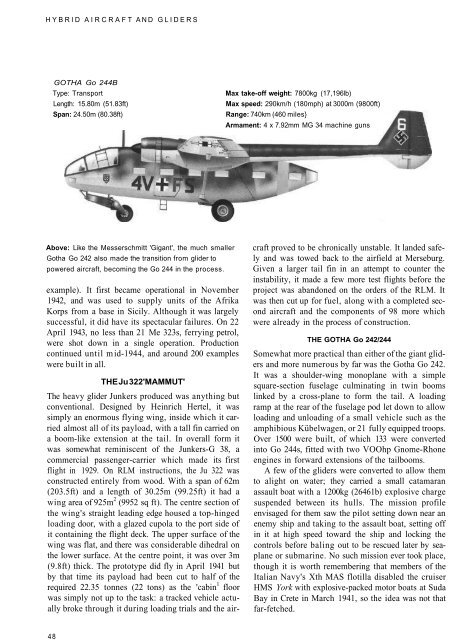Submarines and their Weapons - Aircraft of World War II
Submarines and their Weapons - Aircraft of World War II
Submarines and their Weapons - Aircraft of World War II
Create successful ePaper yourself
Turn your PDF publications into a flip-book with our unique Google optimized e-Paper software.
HYBRID AIRCRAFT AND GLIDERS<br />
GOTHA Go 244B<br />
Type: Transport<br />
Length: 15.80m (51.83ft)<br />
Span: 24.50m (80.38ft)<br />
Above: Like the Messerschmitt 'Gigant', the much smaller<br />
Gotha Go 242 also made the transition from glider to<br />
powered aircraft, becoming the Go 244 in the process.<br />
example). It first became operational in November<br />
1942, <strong>and</strong> was used to supply units <strong>of</strong> the Afrika<br />
Korps from a base in Sicily. Although it was largely<br />
successful, it did have its spectacular failures. On 22<br />
April 1943, no less than 21 Me 323s, ferrying petrol,<br />
were shot down in a single operation. Production<br />
continued until m id-1944, <strong>and</strong> around 200 examples<br />
were built in all.<br />
THE Ju 322'MAMMUT'<br />
The heavy glider Junkers produced was anything but<br />
conventional. Designed by Heinrich Hertel, it was<br />
simply an enormous flying wing, inside which it carried<br />
almost all <strong>of</strong> its payload, with a tall fin carried on<br />
a boom-like extension at the tail. In overall form it<br />
was somewhat reminiscent <strong>of</strong> the Junkers-G 38, a<br />
commercial passenger-carrier which made its first<br />
flight in 1929. On RLM instructions, the Ju 322 was<br />
constructed entirely from wood. With a span <strong>of</strong> 62m<br />
(203.5ft) <strong>and</strong> a length <strong>of</strong> 30.25m (99.25ft) it had a<br />
wing area <strong>of</strong> 925m 2 (9952 sq ft). The centre section <strong>of</strong><br />
the wing's straight leading edge housed a top-hinged<br />
loading door, with a glazed cupola to the port side <strong>of</strong><br />
it containing the flight deck. The upper surface <strong>of</strong> the<br />
wing was flat, <strong>and</strong> there was considerable dihedral on<br />
the lower surface. At the centre point, it was over 3m<br />
(9.8ft) thick. The prototype did fly in April 1941 but<br />
by that time its payload had been cut to half <strong>of</strong> the<br />
required 22.35 tonnes (22 tons) as the 'cabin 1 floor<br />
was simply not up to the task: a tracked vehicle actually<br />
broke through it during loading trials <strong>and</strong> the air-<br />
48<br />
Max take-<strong>of</strong>f weight: 7800kg (17,196lb)<br />
Max speed: 290km/h (180mph) at 3000m (9800ft)<br />
Range: 740km (460 miles}<br />
Armament: 4 x 7.92mm MG 34 machine guns<br />
craft proved to be chronically unstable. It l<strong>and</strong>ed safely<br />
<strong>and</strong> was towed back to the airfield at Merseburg.<br />
Given a larger tail fin in an attempt to counter the<br />
instability, it made a few more test flights before the<br />
project was ab<strong>and</strong>oned on the orders <strong>of</strong> the RLM. It<br />
was then cut up for fuel, along with a completed second<br />
aircraft <strong>and</strong> the components <strong>of</strong> 98 more which<br />
were already in the process <strong>of</strong> construction.<br />
THE GOTHA Go 242/244<br />
Somewhat more practical than either <strong>of</strong> the giant gliders<br />
<strong>and</strong> more numerous by far was the Gotha Go 242.<br />
It was a shoulder-wing monoplane with a simple<br />
square-section fuselage culminating in twin booms<br />
linked by a cross-plane to form the tail. A loading<br />
ramp at the rear <strong>of</strong> the fuselage pod let down to allow<br />
loading <strong>and</strong> unloading <strong>of</strong> a small vehicle such as the<br />
amphibious Kübelwagen, or 21 fully equipped troops.<br />
Over 1500 were built, <strong>of</strong> which 133 were converted<br />
into Go 244s, fitted with two VOOhp Gnome-Rhone<br />
engines in forward extensions <strong>of</strong> the tailbooms.<br />
A few <strong>of</strong> the gliders were converted to allow them<br />
to alight on water; they carried a small catamaran<br />
assault boat with a 1200kg (26461b) explosive charge<br />
suspended between its hulls. The mission pr<strong>of</strong>ile<br />
envisaged for them saw the pilot setting down near an<br />
enemy ship <strong>and</strong> taking to the assault boat, setting <strong>of</strong>f<br />
in it at high speed toward the ship <strong>and</strong> locking the<br />
controls before baling out to be rescued later by seaplane<br />
or submarine. No such mission ever took place,<br />
though it is worth remembering that members <strong>of</strong> the<br />
Italian Navy's Xth MAS flotilla disabled the cruiser<br />
HMS York with explosive-packed motor boats at Suda<br />
Bay in Crete in March 1941, so the idea was not that<br />
far-fetched.


